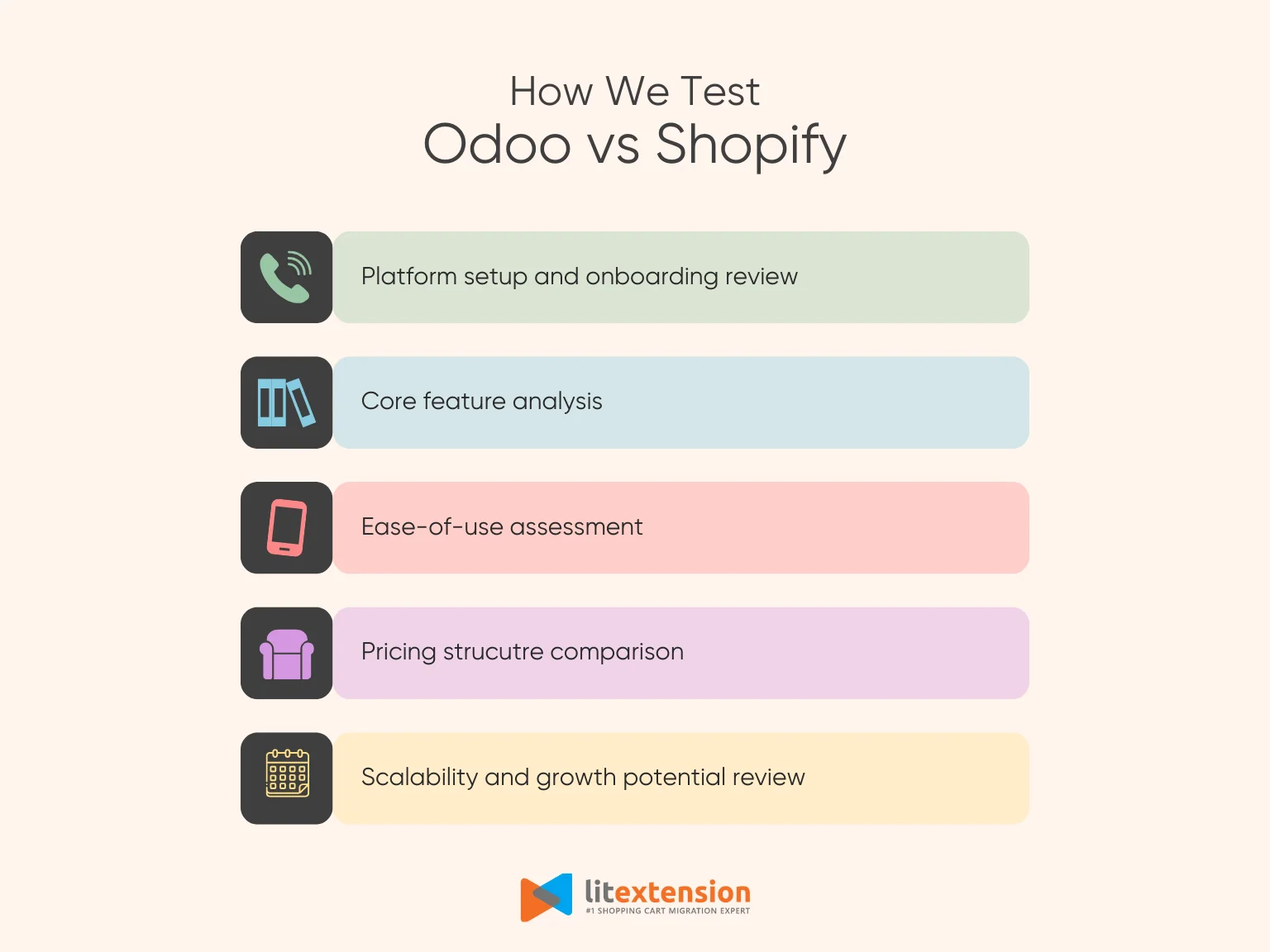Choosing the right platform for your online business is not easy, especially when comparing two very different solutions like Odoo vs Shopify. Both platforms offer strong tools, but they serve different types of businesses and have different goals.
Odoo is recognized for being a flexible and open-source ERP system that addresses various business needs beyond eCommerce, while Shopify is a fully hosted platform that focuses on making online selling simple and effective. Because of these differences, it's essential to compare them side by side to determine which platform is better suited for you.
In this article, let's break down all the differences between Odoo vs Shopify across several criteria, including:
- Ease of use
- Customization and flexibility
- eCommerce features
- SEO & marketing tools
- Apps & integrations
- Scalability
- Security
- Support
- Pricing
We hope that by the end of this article, you'll have a clear idea of which one suits your business best. Let's get cracking!
Odoo vs Shopify – Our Quick Verdict
If you’re short on time and need a quick answer, here’s a fast breakdown of how Odoo vs Shopify compares across the most important criteria. We tested both platforms based on real use cases, and while each has its strengths, the better choice depends on what you're looking for.
Shopify is ideal for businesses that want a user-friendly, all-in-one eCommerce platform without technical headaches. On the other hand, Odoo is better suited for companies that need full control, advanced business management features, or already use other Odoo modules like accounting or inventory.
For a full comparison of these platforms, check out our table below:
Criteria | Odoo | Shopify | The Winner |
Ease of Use | Steeper learning curve due to the open-source nature | Intuitive and beginner-friendly | Shopify |
Customization and Flexibility | Highly customizable with coding | Theme-based and easy to edit | Odoo |
Inventory Management | Built-in advanced tools | Strong features, better for retail | A tie |
Payment Gateways | Limited built-in options | Wide range of built-in integrations | Shopify |
CRM | Native CRM module included | Requires third-party apps | Odoo |
SEO and Marketing | Basic features out of the box | Strong SEO + built-in marketing suite | Shopify |
Apps and Integrations | Requires modules or developer setup | Rich app store with plug-and-play | Shopify |
Scalability | Fully scalable with modular control | Scales well, best for eCommerce | A tie |
Security Compliance | Depends on self-hosting setup | Fully managed, PCI & SSL compliant | Shopify |
Support | Live chat, phone call, and community | Community and resources | Odoo |
Pricing | From $0 to $46.80 per user per month | From $39 to $2,300+ per month | Odoo |
Now that you’ve seen how Odoo vs Shopify compare, the final choice depends on your business type, technical needs, and growth goals. From our experience, you can choose Odoo if you are:
- A business already using Odoo for ERP, CRM, or accounting
- A B2B seller with complex pricing, order flows, or inventory requirements.
- A developer or IT-savvy business owner who wants full control over customization.
- An enterprise or wholesale distributor looking for a scalable ERP + eCommerce solution in one platform.
On the other hand, Shopify will be a better choice if you are:
- A small to medium-sized business owner who wants to start selling online quickly.
- A non-technical user who prefers a plug-and-play solution.
- A dropshipper or print-on-demand seller using third-party services.
An Overview of Odoo vs Shopify
Before diving into detailed comparisons, it's helpful to understand what sets Odoo vs Shopify apart at their core. While both platforms can support online selling, they are built for different types of users and business needs.
Odoo is a modular, open-source business management suite that includes eCommerce as one of its many features. It’s ideal for companies that want to manage everything, from inventory to CRM to accounting, within one platform. Meanwhile, Shopify is a fully hosted eCommerce platform designed for ease of use. It helps users launch and grow online stores without dealing with servers, updates, or heavy technical work.
Let's start by looking at what each platform offers individually.
Understanding Odoo
Odoo is a comprehensive open-source platform designed to help businesses manage a wide range of operations, from eCommerce and sales to inventory, accounting, CRM, and more. Instead of focusing only on online selling, Odoo brings together all the tools a growing business might need under one unified system. This makes it a powerful choice for companies looking to streamline processes across departments and gain more control over their data.
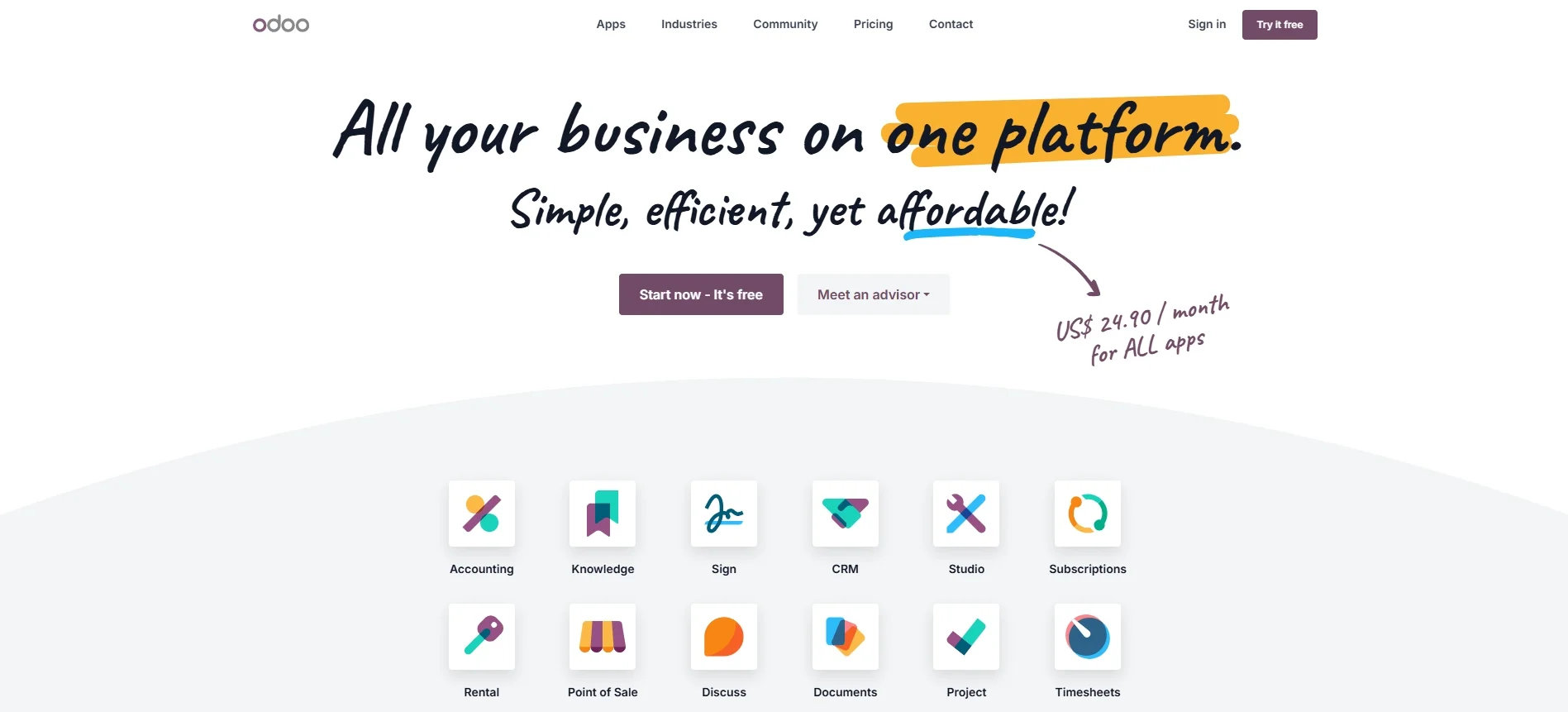
With over 240,000 users worldwide (according to BuiltWith), Odoo has become a popular solution for businesses of all sizes, especially those with technical resources or in-house development teams. Its modular structure allows you to start with just a few apps and expand over time as your needs evolve. Therefore, if you’re looking for a flexible platform that goes beyond selling products online and helps manage your entire operation, Odoo is worth considering.
Here's a quick breakdown of Odoo's advantages and limitations:
Odoo pros | Odoo cons |
- Modular system with apps for every business need. - Free community version with no monthly license fee. - Highly customizable with full access to source code. - Native support for B2B workflows and backend operations. | - Steep learning curve, especially for new users with limited technical skills. - Requires hosting and maintenance if self-hosted. - Limited eCommerce features compared to dedicated platforms. |
Understanding Shopify
On the flip side, Shopify stands among the best eCommerce platforms, built specifically to help individuals and businesses sell products online with ease. Launched in 2006, it has grown to power more than 6.2 million websites globally, supporting everyone from solo entrepreneurs to large-scale retailers. Shopify’s strength lies in its simplicity; users can launch a fully functional online store without writing a single line of code.

Everything from web hosting and security to payment processing and mobile optimization is included, making Shopify a go-to solution for anyone looking to get started quickly. It also offers an extensive app marketplace and hundreds of professional themes, allowing users to customize their store with minimal effort. Hence, it is best suited for those who want a hassle-free way to build and manage an online business.
Here's how Shopify stacks up in terms of pros and cons
Shopify pros | Shopify cons |
- Extremely easy to use with a beginner-friendly interface. - Wide selection of themes and plug-and-play apps. - Built-in hosting, SSL, and automatic updates. - Strong SEO, marketing, and sales tools out of the box. | - Less flexibility for deep backend customizations. - Custom features often rely on paid apps or developer help. |
For more information and expert insights into this platform, please don't forget to check out our Shopify review here or watch the video below:
Ease of Use
The verdict:
Between Odoo vs Shopify in terms of ease of use, Shopify clearly outperforms Odoo. It’s built for users who want to launch a store without technical barriers, making it the better choice for most small to medium-sized businesses. Hence, if your goal is to get started quickly with minimal setup, Shopify is the way to go.
When comparing Odoo vs Shopify in terms of ease of use, the contrast is clear, especially in how each platform handles setup, customization, and day-to-day management. While both platforms can support online selling, their learning curves and user experiences are very different.
Odoo offers powerful tools and deep customization, but that power comes with complexity. Since Odoo is built as an all-in-one business management suite, setting up your online store often involves installing and configuring multiple modules, such as eCommerce, Inventory, CRM, and Sales. Each module must be integrated properly to ensure smooth operations.
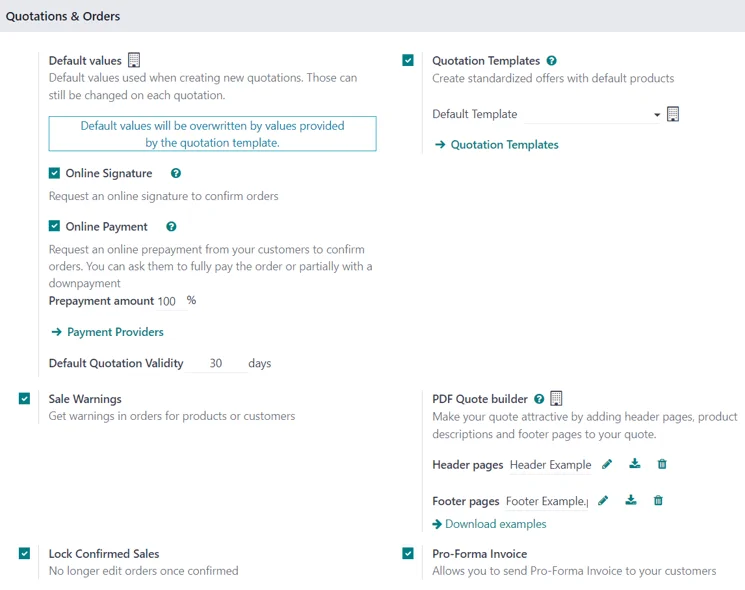
The interface is clean and consistent across modules, but it's designed for internal business users, not casual store owners. Many settings aren’t self-explanatory, and even basic design customizations can involve backend development. For businesses with in-house tech teams or external developers, this might not be a barrier. But for beginners or small teams, it can be a challenge.
In contrast, Shopify is designed to be as easy as possible for anyone to use, regardless of technical experience. You don’t need to worry about servers, installations, or software maintenance. Once you create an account, Shopify walks you through every step: from selecting a theme and adding products to setting up payment gateways and launching your store.
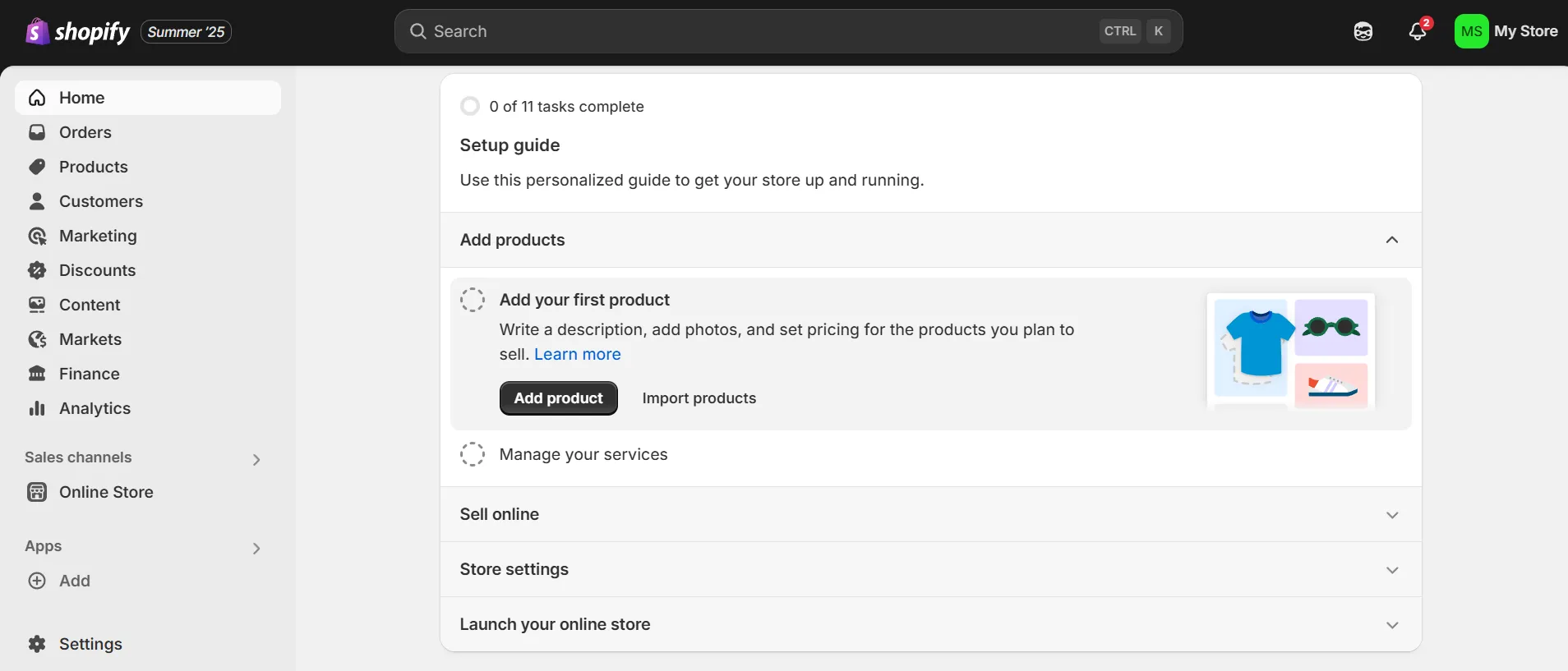
The platform offers a simple dashboard with clear menus and quick access to everything you need. Even design customization is handled through a visual editor, and the app store provides one-click integrations to extend your store's functionality. For users who want to start selling quickly, Shopify minimizes setup time and lowers the learning curve significantly.
Customization and Flexibility
The verdict:
Odoo clearly takes the lead in the Odoo vs Shopify customization and flexibility competition. It gives you full control over your store and backend systems, making it a better choice for businesses with specific or complex requirements. Therefore, if flexibility is your top priority, Odoo is the stronger option to choose.
When it comes to customization and flexibility, Odoo vs Shopify deliver very different experiences. Odoo is built for full control and deep customization across your entire business, while Shopify focuses on simplicity and ease of use, with more structured customization options.
Odoo shines when it comes to customization. Since it’s an open-source platform (especially in the Community edition), you have full access to the codebase. This means you can modify every part of the system, from the storefront and product pages to backend workflows and business logic. Besides, since the platform is modular, you can install only the apps you need, or even develop your own modules if something’s missing. This is perfect for businesses with unique workflows or industry-specific requirements.

However, this level of freedom comes with a catch: you’ll need technical knowledge or a development team to fully take advantage of it. Customizing Odoo isn’t always straightforward, and even small changes may involve code-level adjustments.
On the flip side, Shopify offers a wide range of professionally designed Shopify themes that are easy to apply and edit using the built-in theme editor. For most businesses, the drag-and-drop interface is enough to adjust layouts, colors, fonts, and sections, without touching any code. Additionally, for advanced users, Shopify also allows you to access and modify theme files using Liquid (its templating language). While not as flexible as full open-source platforms, it strikes a good balance between ease and control.

When it comes to functionality, Shopify’s flexibility depends largely on its App Store. You can extend your store using thousands of pre-built apps, which are easy to install and configure. However, if you need something very custom or outside the scope of existing apps, development may be limited by Shopify’s API rules and hosted environment.
eCommerce Features
Both Odoo and Shopify offer the core tools you need to run an online store, but the way they deliver these features is very different. Shopify is built specifically for eCommerce, so it comes with everything you need right out of the box. Odoo, on the other hand, includes eCommerce as part of a broader business management suite, which means its features are deeply connected to other modules like inventory, sales, and CRM.
In this section, we’ll break down how Odoo vs Shopify compare in three key areas that matter most to online sellers:
- Inventory and order management
- Payment gateways
- Customer relationship management (CRM)
Let's take a closer look at each one.
Inventory and order management
The verdict:
Between Odoo vs Shopify, Odoo comes out ahead in inventory and order management, especially for businesses with complex logistics, multi-warehouse operations, or B2B workflows. Its features are more advanced and deeply integrated across other business functions.
When it comes to managing inventory and processing orders, Odoo vs Shopify take different approaches based on their platform design.
Odoo offers a powerful inventory and order management system that is fully integrated with other business modules like sales, purchasing, and accounting. It’s designed to handle complex workflows, including multi-warehouse management, custom routing, batch picking, barcode scanning, and real-time stock adjustments. You can set up automated stock rules, dropshipping workflows, and backorder processes, all from a single dashboard.

For businesses that deal with wholesale, manufacturing, or large-scale logistics, Odoo provides the flexibility and depth needed to manage inventory efficiently. However, setting it up properly can be time-consuming, especially for users unfamiliar with ERP systems. It’s best suited for companies that need a complete backend solution rather than a simple storefront.
Meanwhile, Shopify inventory management includes all the essential tools you need to run a retail or online store. You can track stock levels, manage fulfillment, set up low-stock alerts, and organize products across multiple locations. Shopify also supports automatic inventory syncing with apps, suppliers, or POS systems
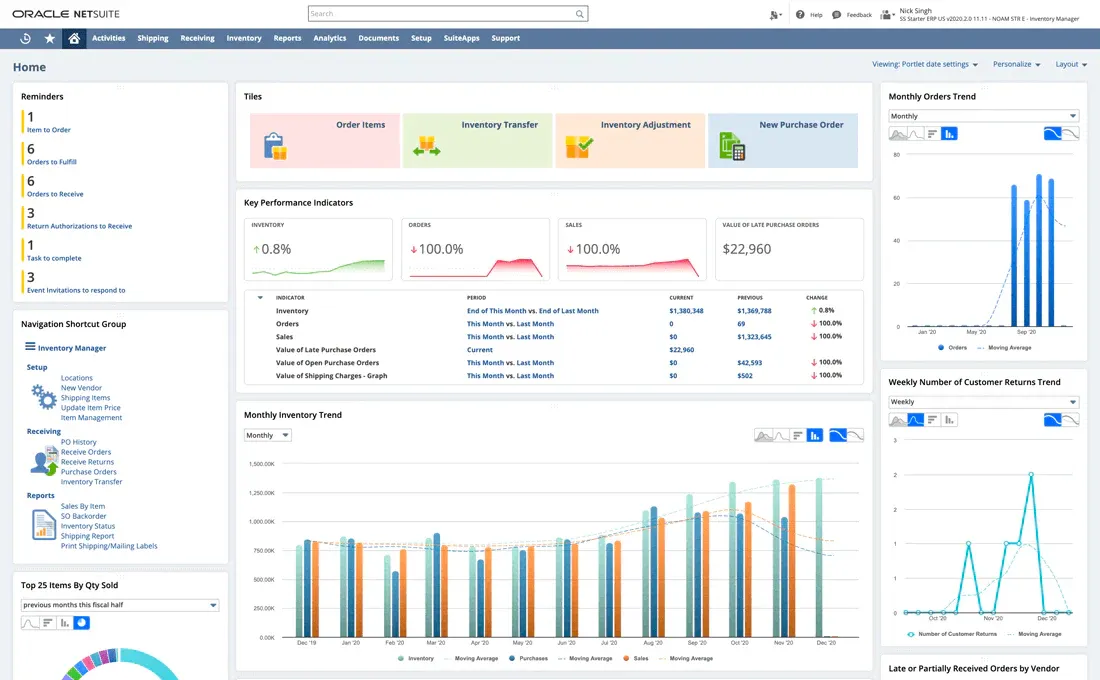
The order management process is intuitive and built into the dashboard, allowing users to filter, track, and fulfill orders quickly. It’s ideal for small to mid-sized businesses that want a streamlined solution without managing complex supply chains.
That said, Shopify may not be as flexible as Odoo when it comes to customizing fulfillment workflows or handling very large or multi-step operations. You’ll likely need third-party apps to extend its capabilities.
Payment gateways
The verdict:
In terms of payment gateway support, Shopify is the clear winner in the Odoo vs Shopify competition. It offers broader coverage, easier setup, and seamless integration, especially with Shopify Payments. Therefore, if fast and flexible payment integration is a priority, Shopify is the better choice.
Odoo provides support for a variety of payment gateways, including widely used providers such as PayPal, Stripe, Authorize.net, and Adyen, along with several region-specific gateways that cater to local markets. These payment options are made available through installable modules in the Odoo Apps marketplace, allowing you to choose and activate only the integrations you need for your business.

However, the integration process is not always straightforward. Unlike plug-and-play systems, Odoo often requires manual configuration and technical setup, especially if you're using the self-hosted Community version. Businesses may need a developer to handle installation, API keys, error handling, and even user interface adjustments. This becomes even more important when dealing with non-standard gateways, complex payment conditions, or multiple currencies.
On the other hand, Shopify sets the standard for ease of use and breadth of payment options in the eCommerce world. Out of the box, it supports over 100 payment gateways across global markets, including major players like Stripe, PayPal, Amazon Pay, Klarna, Apple Pay, and Google Pay. These integrations are already built into the system and can be enabled in just a few clicks, with minimal setup required.
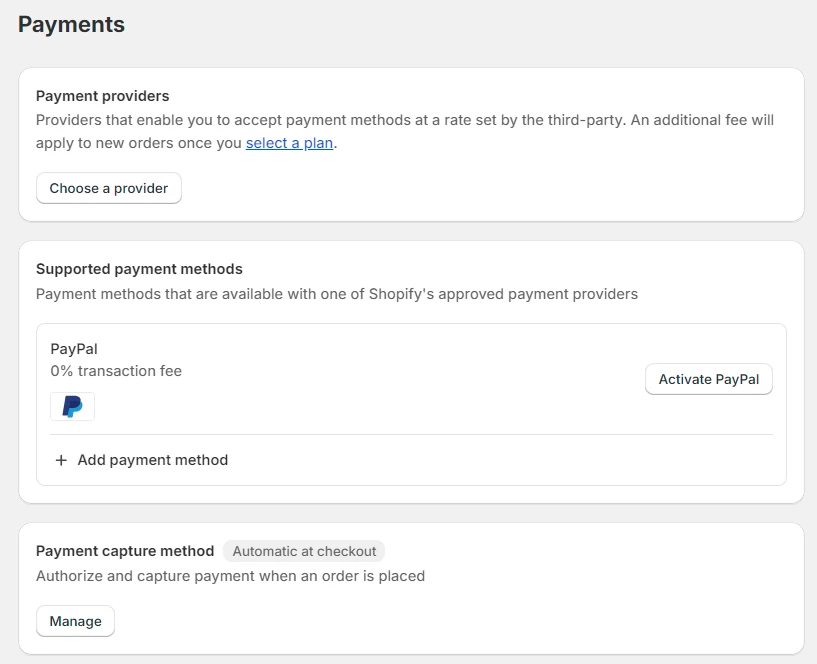
What makes Shopify even more convenient is its native payment solution, Shopify Payments. This feature removes the need for third-party processors entirely, allowing merchants to manage transactions directly through their Shopify dashboard. It supports multiple currencies, local payment methods, and automatic fraud analysis, all while avoiding extra transaction fees that usually come with third-party gateways (as long as you use Shopify Payments).
Customer relationship management (CRM)
The verdict:
When comparing Odoo vs Shopify in terms of CRM functionality, Odoo is the winner. Its native CRM module is deeply integrated with other business processes, giving you a centralized view of your customer lifecycle, from lead generation to post-sale support.
Odoo includes a native CRM module that is tightly integrated with its eCommerce, Sales, Helpdesk, and Marketing apps. This means you can manage every customer interaction, before, during, and after the sale, from a single dashboard. Whether you're handling B2B sales pipelines, scheduling follow-up activities, or tracking customer communications, Odoo gives you enterprise-grade tools to do it all.

The CRM module includes features like:
- Lead and opportunity tracking
- Sales team assignment and forecasting
- Activity scheduling and follow-ups
- Customer segmentation and lifetime value analysis
- Integration with email marketing and automation workflows
This level of control makes Odoo ideal for businesses that want to manage complex customer relationships, especially in B2B, wholesale, or service-based industries. However, getting the most out of Odoo’s CRM may require some customization and training, as the tools are robust but not always beginner-friendly.
In the meantime, Shopify does not come with a built-in CRM in the traditional sense. Instead, it offers basic customer management features, such as order history, contact details, tags, and customer groups. These features are enough for tracking purchase behavior, managing returns, or segmenting customers for marketing purposes.
For more advanced CRM capabilities, Shopify relies heavily on third-party apps from its App Store. Apps like Klaviyo, HubSpot, Omnisend, and Salesforce can be integrated easily to add customer tracking, segmentation, email marketing automation, and loyalty programs.
While this gives Shopify users access to powerful CRM tools, it does require additional subscriptions and configuration. The upside is that many of these apps are user-friendly and designed to work out of the box.
SEO and Marketing Tools
The verdict:
In terms of SEO and marketing tools, Shopify is the clear winner between Odoo vs Shopify, especially for businesses focused on fast growth and traffic generation. It offers better out-of-the-box SEO, easier marketing setup, and seamless integrations with major ad platforms and email tools.
Odoo includes built-in SEO tools that allow you to edit page titles, meta descriptions, and URLs. You can also generate sitemaps and manage canonical tags to avoid duplicate content issues. However, most of these features are fairly basic and may require manual configuration.
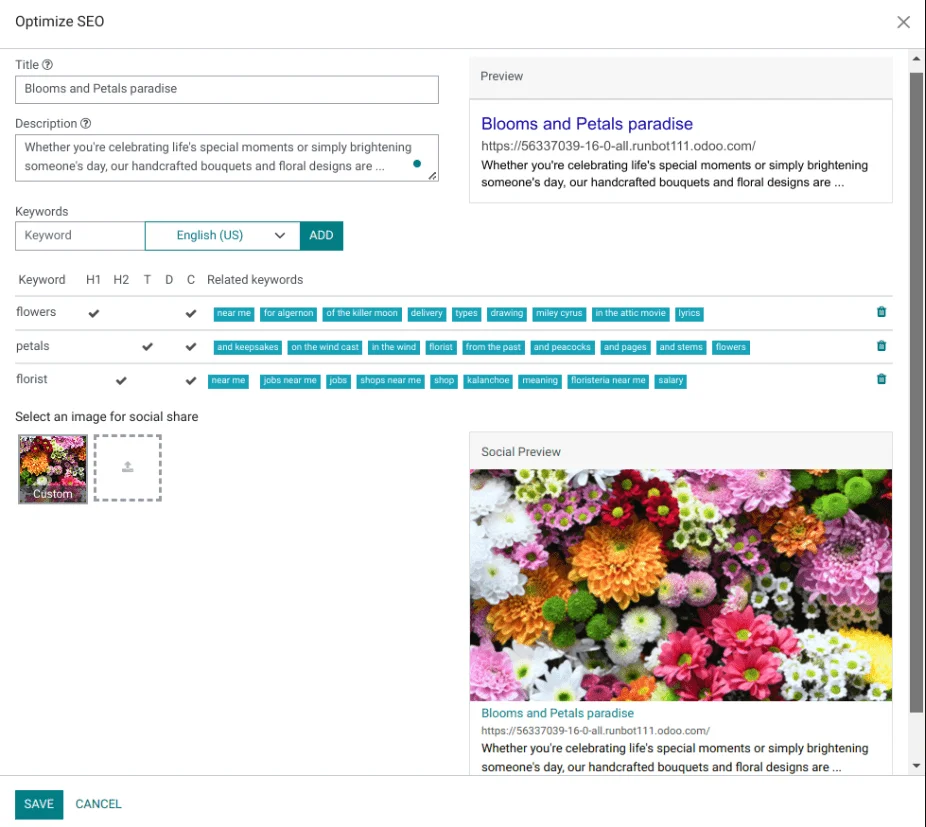
When it comes to marketing, Odoo provides a wide range of native modules, including:
- Email marketing with drag-and-drop templates
- Marketing automation for creating customer journeys
- SMS marketing, push notifications, and loyalty programs
- Social media scheduling and campaign tracking
These tools integrate directly with Odoo’s CRM and eCommerce modules, giving you a complete view of customer behavior and campaign performance. However, the setup can be complex, and users may need technical support to make the most of these features.
In contrast, Shopify is known for its SEO-friendly structure, which includes automatic sitemap generation, mobile optimization, fast loading speeds, and clean URLs. Store owners can easily edit meta titles, descriptions, alt texts, and custom URLs from the admin dashboard, no coding required.
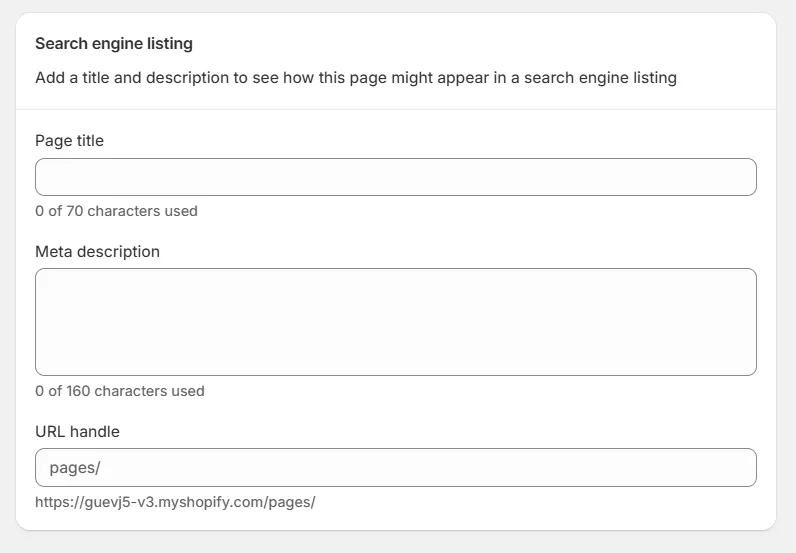
For marketing, Shopify offers several built-in tools like:
- Shopify Email for sending branded newsletters
- Discount and promotion engine for running sales
- Built-in blogging platform to support content marketing
- Marketing dashboard to track performance
In addition, Shopify’s App Store provides hundreds of third-party marketing apps, including Klaviyo, Mailchimp, Google Ads, Facebook Ads, and more. These integrations are easy to install and allow you to run targeted campaigns without building complex workflows from scratch.
Apps and Integrations
The verdict:
In the comparison of Odoo vs Shopify for apps and integrations, Shopify wins for its ease of use and massive app ecosystem. It’s ideal for businesses that want to quickly extend functionality without needing custom development. For those who prioritize convenience, scalability, and fast deployment, Shopify is certainly the better choice.
Odoo offers a wide range of modules that cover everything from sales and finance to logistics and marketing. These modules are developed and maintained by Odoo and its global community. If you're using the Enterprise version, you also get access to official integrations with platforms like Amazon, eBay, DHL, QuickBooks, and more.
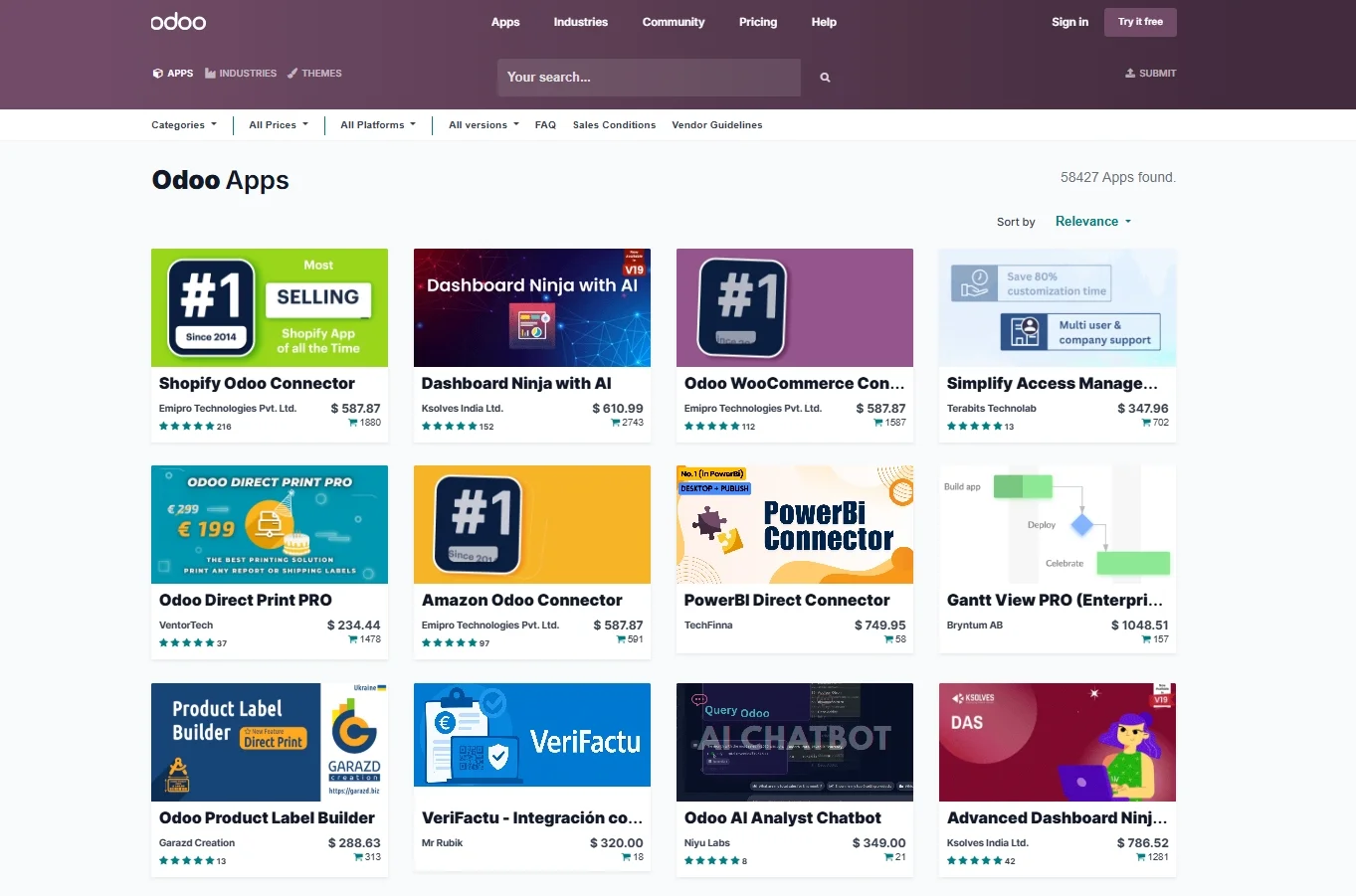
Because Odoo is open-source, it's extremely flexible; you can build or modify modules to fit your exact needs. This is a major advantage for businesses with unique workflows or internal systems. Additionally, Odoo's API is well-documented, making it suitable for developers who want to create custom integrations.
However, most integrations are not plug-and-play. They often require manual configuration, technical knowledge, or third-party developers to fully set up and maintain. This can be a barrier for small businesses without in-house IT support.
In the meantime, Shopify offers one of the largest and most user-friendly app ecosystems in the eCommerce world. Its App Store features over 8,000 apps, covering everything from email marketing and product reviews to print-on-demand, ERP systems, and accounting software. Most Shopify apps are plug-and-play, meaning they can be installed and activated with just a few clicks, no coding required.

Shopify also supports robust API access for developers, making it easy to build private apps or connect with third-party systems. Plus, with tools like Shopify Flow and Shopify Functions (on higher-tier plans), you can automate workflows and customize backend operations without leaving the ecosystem.
Scalability
The verdict:
In terms of scalability, both platforms are strong, and it's a tie in this Odoo vs Shopify comparison. Shopify is ideal for growing eCommerce brands that want a hassle-free platform that scales automatically with their traffic and sales. Odoo, on the other hand, is better suited for businesses with complex operations, especially those looking to scale across multiple departments beyond eCommerce.
Odoo is built for scalability through its modular architecture. You can start with a few core applications, like eCommerce, Inventory, and Sales, and gradually add more modules as your needs evolve. This makes it an ideal solution for businesses that plan to scale beyond just online sales and into areas like warehouse management, manufacturing, accounting, or customer support.
However, scaling Odoo requires technical involvement. As your system grows, maintaining performance, upgrading modules, and handling integrations may require a development team or managed service provider.
Meanwhile, Shopify is designed to scale automatically, with no infrastructure management required. Whether you’re processing a few orders a day or handling thousands, Shopify’s hosted platform ensures fast load times, secure checkout, and reliable uptime, even during peak traffic events like Black Friday or major product launches.
All Shopify plans come with performance optimization and global CDN support, while higher-tier plans like Shopify Advanced or Shopify Plus offer additional tools for automation, reporting, and international expansion. You can easily add new sales channels (like Instagram, Amazon, or TikTok), manage multiple locations, and serve international markets with multi-currency and multi-language support.
Security
The verdict:
In terms of security compliance, Shopify takes the lead in the Odoo vs Shopify competition. Its fully managed infrastructure, PCI compliance, and built-in SSL make it the safer and easier choice for businesses that don’t want to worry about manual security tasks.
Odoo’s security largely depends on how and where it’s hosted. If you're using the self-hosted Community version, you are responsible for securing your own server, managing SSL certificates, installing security updates, and ensuring compliance with data protection regulations like GDPR or PCI DSS. This gives you full control, but also full responsibility.

Odoo also includes features like two-factor authentication (2FA), access control lists, and audit trails, which are helpful for businesses that require a strict security framework. Still, businesses using Odoo must stay proactive in maintaining compliance, especially when scaling or customizing the system.
In contrast, Shopify is a fully hosted platform, which means all core security responsibilities are handled for you. It comes with SSL certificates by default, so all stored data is encrypted during transmission. Shopify is also Level 1 PCI DSS compliant, ensuring that your store meets the highest standards for payment data security.
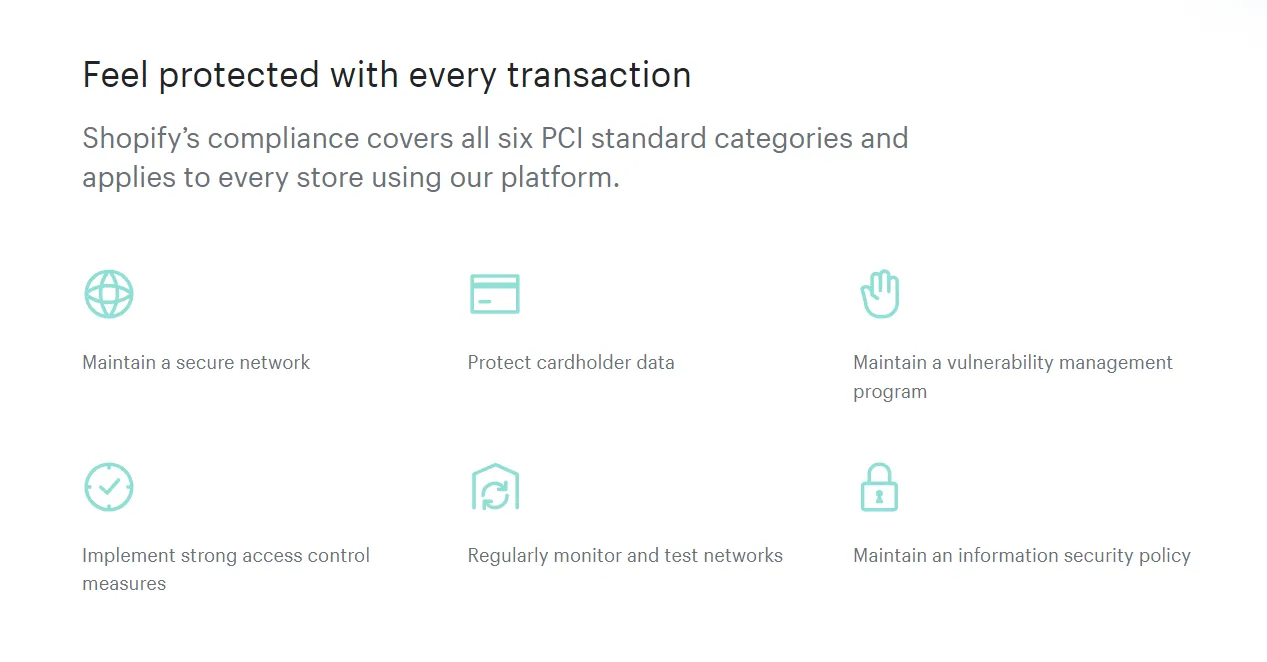
Security updates, patches, and infrastructure management are all automated, so store owners don’t need to worry about manual server maintenance. Shopify also includes features like:
- 24/7 monitoring for threats and breaches
- Built-in fraud analysis for orders
- Role-based permissions for staff accounts
- Two-step authentication for admin users
Because everything is managed in the cloud, Shopify provides peace of mind for store owners who want enterprise-grade protection without technical overhead.
Support
The verdict:
When it comes to Odoo vs Shopify in support accessibility and responsiveness, Odoo takes the lead, thanks to its continued live chat and phone support. If direct, real-time support is important to you, Odoo currently provides a more comprehensive and responsive experience.
- Odoo provides several support channels for users, including:
- Live chat and phone support with Odoo’s in-house team
- A growing community forum with input from developers and users
- A comprehensive Help Center and documentation library
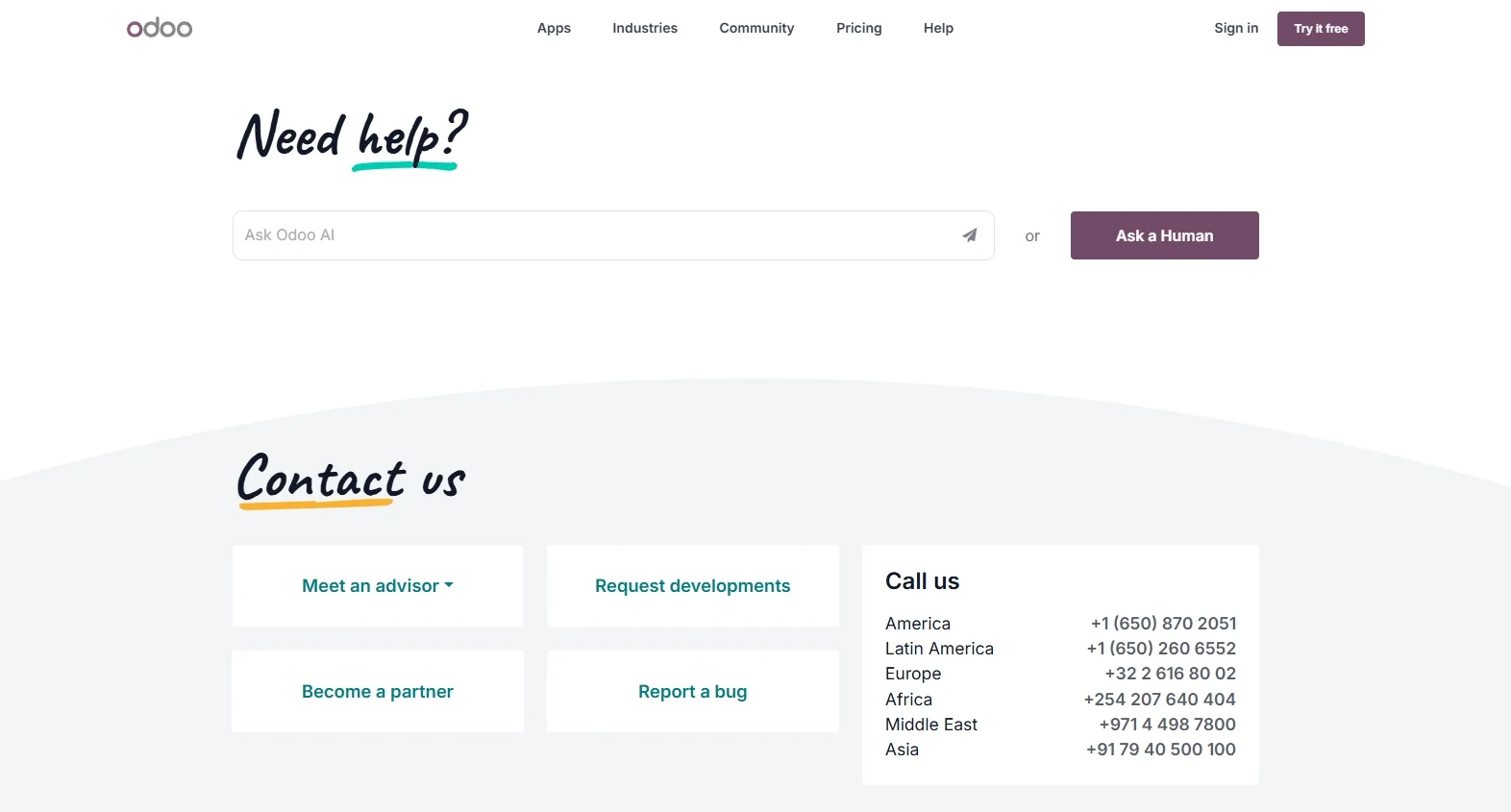
The quality of support is generally good for Enterprise users, with personalized assistance available for setup, bug fixes, and module configuration. Additionally, Odoo also works with a global network of certified partners, who can offer implementation and long-term support packages tailored to specific industries or business models. This makes Odoo a strong choice for businesses with technical needs and long-term growth plans
Meanwhile, Shopify offers support through various channels, including:
- 24/7 email support, with a ticketing system for detailed inquiries
- A rich Help Center filled with step-by-step guides, videos, and best practices
- A vibrant community forum moderated by Shopify staff and experts

While direct assistance through live chat is now limited to email, Shopify still delivers one of the most user-friendly support ecosystems, especially for non-technical users. Most store owners can find answers quickly through self-service resources or community discussions, and Shopify’s documentation is consistently updated and beginner-focused.
Pricing
The verdict:
Between Odoo vs Shopify in pricing, Odoo takes the lead for its pricing flexibility, especially for small teams or businesses that only need one or two apps. The free plan and low per-user cost make it appealing for lean operations.
Odoo and Shopify take very different approaches to pricing, which can significantly affect your total cost depending on the size and structure of your business.
Odoo offers a more modular pricing model. You can start with the One App Free plan at $0, which is ideal if you only need one function, such as CRM or Inventory. For broader access, the Standard plan costs $9.10 per user/month, giving you access to all Odoo apps through Odoo Online.
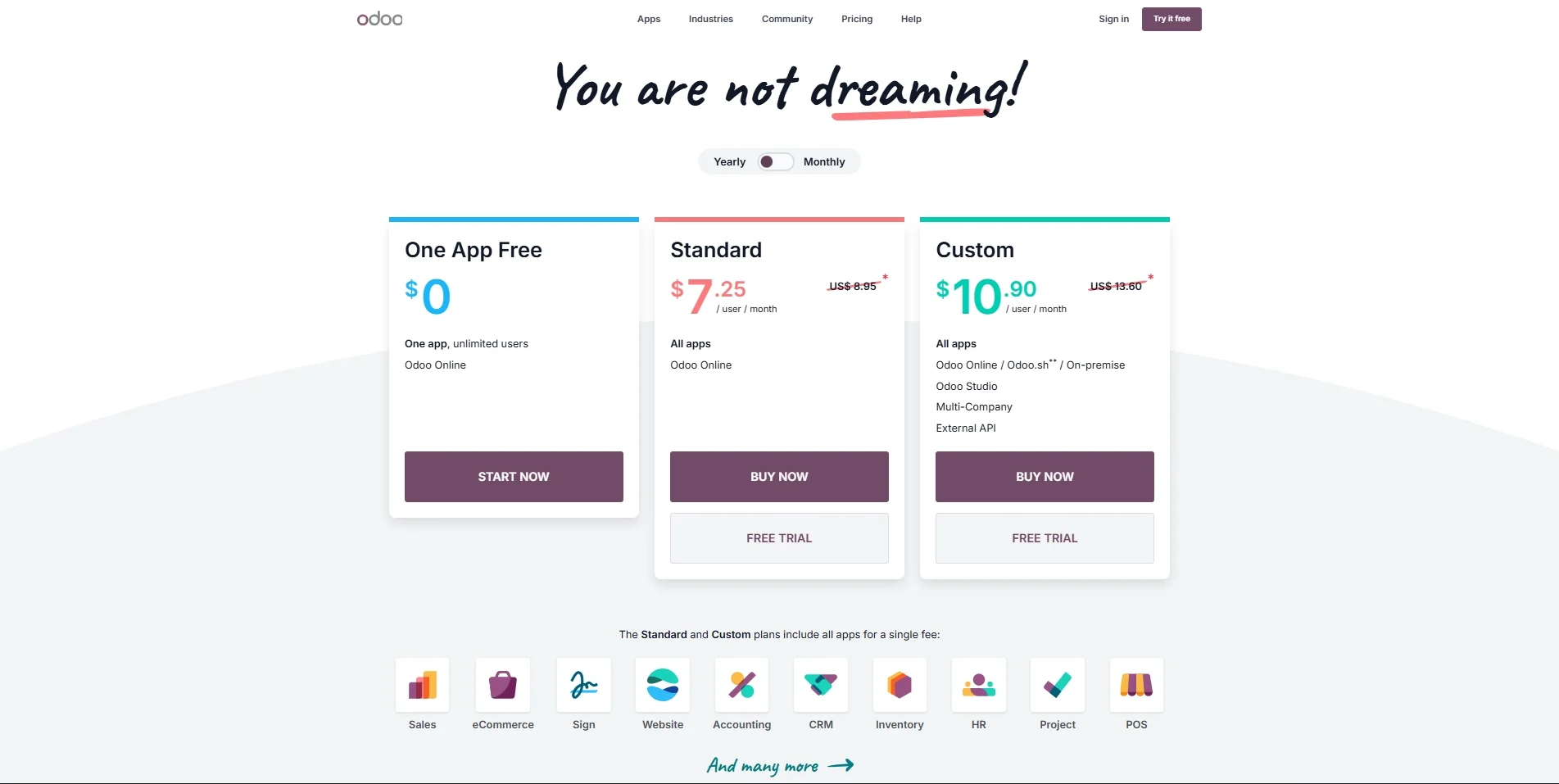
Additionally, if you need more flexibility, such as using Odoo.sh, multi-company support, or external API access, the Custom plan is available at $13.60 per user/month. This per-user pricing can be cost-effective for smaller teams but may scale up quickly as your team grows.
Shopify pricing, on the other hand, offers fixed monthly pricing, starting at $39/month for the Basic plan. This includes support for up to 10 inventory locations, 24/7 chat support, and in-person selling features. The Grow plan at $105/month adds support for up to 5 staff accounts and better shipping discounts.

As your business scales, the Advanced plan at $399/month and the Plus plan at $2,300/month (on a 3-year term) provide more advanced features like customizable checkout, local storefronts, and wholesale/B2B capabilities. Pricing doesn’t increase with more users, making it easier to predict costs, especially for growing teams.
Our Methodology: How We Test Odoo vs Shopify
To build an accurate and helpful comparison of Odoo vs Shopify, we followed a hands-on, research-driven process focused on real business needs. Here's how we approached it:
- Platform setup and onboarding review: Hands-on testing of store creation and initial configuration using trial accounts on both Odoo and Shopify.
- Core feature analysis: A side-by-side comparison of essential eCommerce tools, including product management, inventory, CRM, and marketing features.
- Ease-of-use assessment: Evaluation of dashboard navigation, store management tasks, and overall user-friendliness for beginners and non-technical users.
- Pricing structure comparison: Cost analysis across different business scenarios, from solo users to growing teams, with consideration for user-based vs. flat-rate pricing.
- Scalability and growth potential review: Examination of multi-user support, international selling capabilities, and performance under business expansion.
This structured approach ensures that our Odoo vs Shopify comparison is thorough, balanced, and aligned with the needs of both new and experienced eCommerce users.
Odoo vs Shopify – FAQs
Which one is better, Odoo or Shopify?
It depends on your business needs. Odoo offers a flexible, modular system ideal for businesses that want to manage everything (eCommerce, CRM, inventory, accounting) in one place. It’s especially suitable for teams that need custom workflows and are comfortable with a more technical setup.
Shopify, on the other hand, is designed specifically for eCommerce and is much easier to use, making it a better choice for store owners who want a quick and reliable setup with minimal technical work.
Does Odoo work with Shopify?
Yes, Odoo can be integrated with Shopify using third-party connectors or custom-built integrations. This allows you to sync data like products, inventory, and orders between the two platforms. However, these integrations may require additional configuration and come at an extra cost, depending on the tool or service used.
Does Odoo have eCommerce?
Yes, Odoo includes a built-in eCommerce module that lets you create an online store, manage products, accept payments, and handle customer orders. It’s fully integrated with other Odoo apps like Inventory, Sales, and Accounting, offering a complete business management system in one platform.
Why choose Shopify over Odoo?
Shopify is a better option if your main focus is selling online and you want a platform that’s fast, simple, and fully hosted. It comes with built-in themes and a huge marketplace for app integrations, which makes it ideal for entrepreneurs and growing eCommerce brands. Unlike Odoo, Shopify doesn’t require much setup or technical knowledge, which helps you launch your store faster.
Final Words
To conclude, both Odoo and Shopify offer powerful tools for building and growing an online business, but they serve different needs. Odoo stands out with its all-in-one approach, combining eCommerce with inventory, CRM, accounting, and more. In contrast, Shopify focuses entirely on making eCommerce simple, fast, and reliable with its user-friendly interface, ready-to-use themes, and extensive app ecosystem.
Ultimately, the right choice between Odoo vs Shopify depends on your priorities: if you want a streamlined eCommerce experience, Shopify is likely the better fit. If you’re building a larger system with integrated business functions, Odoo might offer more value in the long run.
Last but not least, if you like this post, please don't forget to check out other articles on our LitExtension blog for more expert tips and insights.
